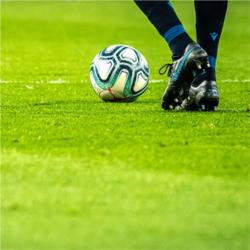
The statistics are disturbing when reviewed from the point of view of a professional football player or sports club. To think that the average football team of 25 players experiences around 50 injuries over a season is overwhelming because each player gets injured around two times a year. According to a study, football-related injuries are one of the main reasons for the career end of professional athletes. Sadly, few studies document the consequences of injuries on players’ careers and retirement years. From what we know, 62% of the interviewed football players stated that a football-related injury is a cause for ending their careers. Most injuries are located in their lower extremities, usually on their ankles and knees.
Besides negatively affecting the players’ careers and overall health, injuries also impact football clubs as they experience financial loss. Sometimes a professional football player getting injured can cause a negative scenario like a lost game or championship. Even if professional clubs have implemented several measures over the years to prevent injuries and help their athletes recover as soon as possible, the injury rate is still high among football players.
The incidence of injuries in professional football
A publication documented the injury incidence in the football world and concluded that the injury rate is 8.1/1000 hours of exposure. Of course, in a competitive sport like football, game injury incidence is 10 times higher than injury incidence in other contexts like training. Most players experience lower extremity injuries which often turn daunting because they prevent them from performing. Trunk and upper limbs injuries are less common in this sport, but they still suffer from health issues affecting these areas. The most common lower link injuries are injuries of the tendons and muscles, bruises, bone fractures, bone stress injuries, and lacerations. Usually, they need from 1 to 3 days of time to recover from an injury, but some moderate injuries can keep them off the field for even a month.
A higher incidence of injuries happens in international tournaments, with 41.1 injuries/1000 hours of exposure during international games and 32.3 injuries/1000 hours of exposure.
Common injuries in football players
Professional players are prone to injuries because football is a high-energy sport that facilitates injuries. You don’t have to play professional football to know what can happen when someone runs at high speed and another player tries to stop their progress. As seen above, research highlights that the most common injuries affect the lower body. Most football players experience injuries such as sprained ankles, knee injuries, anterior cruciate ligament injuries, groin strains, or hamstring strains. Because they are prone to falling, they can also injure their hands and wrists or get concussions.
The factors that lead to injuries are:
- Running
- Tackling
- Turning
- Twisting
- Landing
- Jumping
- Using the same muscles repeatedly
- Colliding with an opponent
- Foul play
- Hurting a body part they injured before
- Lack of physical conditioning
Let’s discuss in detail the complexities of each injury.
Sprained ankles
Football players often run on uneven surfaces and have to change direction quickly. This can cause their ankles to roll outwards or inwards and outstretch the ligaments that stabilise their ankle joints. Playing with an injured ankle can trigger severe damage that delays recovery. To prevent this from happening, football clubs work with experts specialised in first aid to ensure someone can efficiently intervene when a player gets injured to minimise the extent of their injury. Companies like Skills Training Group offer first aid courses for football medical teams to provide them with the necessary education to treat any kind of football-related injuries.
Hamstring strain
The hamstrings are three large and powerful muscles located on the back of the thigh. They produce a driving force during acceleration when the athletes run. During a football match, the players change the pace quickly and sometimes have to go from a standstill to sprinting in a couple of seconds. If their hamstrings lack the necessary strength or length (from stretching) can become overloaded and experience strain.
Groin strain
When the players train or play during football matches, they twist, pitch, jump, and run, activities that could injure their inner thigh muscles. Health specialists refer to this issue as a groin strain and recommend that players stretch their inner thighs regularly to prevent this.
Anterior cruciate ligament (ACL) injury
The anterior cruciate ligament is crucial for stabilising the knees and can easily get injured when the feet stay planted, and the upper part of the legs move or twist. Football players usually suffer anterior cruciate ligament injury when they land from a jump while in motion or are tackled to the ground. Most times ACL injuries require surgery, but if the ligament is only sprained, they can improve its condition with rehabilitation or physiotherapy.
Shoulder injuries
As mentioned before, football players are also prone to upper body injuries like shoulder injuries that are often the consequence of a fall with significant impact. Common shoulder injuries among athletes include tears or dislocations of the rotator cuff muscles.
Concussions
Concussions result from a direct hit on the skull and usually occur after an indirect impact that causes a sudden jerk in the head. Concussions make football players experience drowsiness, dizziness, nausea, headaches, or loss of balance.
Overuse injuries
Accumulated strain on the tissue triggers overuse injuries that can prevent a player from performing efficiently on the field. Worn-out footwear, suboptimal playing surfaces, faulty technique, or inadequate warm-up can cause overuse injuries.
Conclusion
Professional footballers are at high risk of injuring themselves during training or matches. The most common injuries include ankle injuries, ligament injuries, shin splints, hand or wrist injuries, and muscle strains. Football is a highly demanding physical activity that makes athletes prone to injuries due to the continuous contact with other players and the movements they need to perform when playing.
Image source https://unsplash.com/photos/AWdCgDDedH0